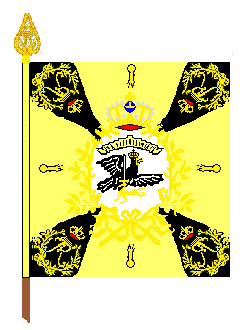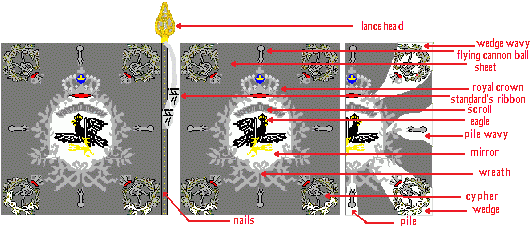|
Infantry Regimental Colours in Times of Friedrich the Great
Brandenburg suffered heavily during the 30-Years War (1618-1648) and lost an estimated 1/3 of its population. Under the rule of Friedrich Wilhelm I (the Great Elector), the administration of Brandenburg was consolidated. Refugees from all over Europe settled down in Brandenburg and agriculture and industries were improved. Under the Great Elector the size of the army was increased from 8,000 to 23,000 men.

Normally, a black Prussian Eagle was used on military colours after 1701, prior to this time
Brandenburg used a red eagle, armed and golden tongued. This example of the black eagle was embroidered c1740. When Marquis and Elector Friedrich III crowned himself Friedrich I, King in Prussia, in 1701, the design of the regimental colours was changed. In the center of the flag was a slightly oval disc, called the "mirror." Within the mirror was a black rising eagle, the Eagle of Prussia. The eagle was placed above a landscape and faced a sun. There was an additional scroll within the mirror having the motto "NO SOLI CEDIT" (He even does not give way to the sun). His son, King Friedrich Wilhelm I (the soldier king), made further improvements in all branches of the military and admitted to the country 15,000 fugitives from Catholic Salzburg Archbishopric. Friedrich Wilhelm also increased the personnel of his army up to 83,000 men, a very large military when you consider that Brandenburg had only just 2.5 million inhabitants then.

This new pattern was introduced by Friedrich II containing the motto
"PRO GLORIA ET PATRIA" over the eagle as illustrated here
on the Colours of the Infantry Regiment No. 46 Fusiliers.
His son, Friedrich II raised eight new regiments at the eve of the 1st Silesian War between 1740 to 1742, and another 17 regiments until the beginning of the 2nd Silesian War between 1744 to 1745. (1)
Ever since 1735, a Prussian infantry regiment consisted of two battalions, each having five companies of musketeers and one company of grenadiers. In action both grenadier companies formed their own battalion. During war a regiment had 50 officers, 118 NCOs, 50 musicians, 12 carpenters, 196 grenadiers and 1220 musketeers. Until January 1757, the staff increased up to 1800 men in the regiment and another 754 in the grenadier battalion. On their standards, below the mirror "infantry regiment no.x" is always abbreviated as "i.r.x"
The Regimental Colours

Examples of Regimental Colours displayed in front of their Colonel's Colours.
The colours shown are the 19th Infantry Regiment (left), the 27th Infantry Regiment (middle); and the 40th Infantry Regiment (right).
Design Characteristics:
- According to sources in 1740, the flags were square (150cm x 150cm), however, the paintings of the flags always show a ratio of approximately 19:18 with the height being slightly bigger.
- Each regiment had 10 Colours, one for each musketeer company. The grenadier company had no flag of its own.
- The flags were of very cheap quality, they were made of thin silky taffeta. The ornaments were simply been painted upon the flags in oil color. The ornaments were a wreath surrounding the mirror and topped by a royal crown. In each corner was a cypher showing just initials without the "number" of the ruler. A flying cannonball outward bound was in the middle of each quarter. The ornaments were either golden or silvery depending on the sheet (background) color, and usually matched the colour on the colour of their uniform buttons.
- The 1st company always had a special flag called the Leibfahne or "Colonel´s Colour" on a white sheet (background), although a regiment often was commanded by officers of higher rank. The other nine companies of the regiment all had the same flags, Regimental Colours (Ordinärfahnen), without any distinguishing marks. Their sheets (backgrounds) were not white, but distingue regiment color.
- The regiments were only distinguished by the colors of their flags.
- The typical Regimental Colours had a non-white sheet with a white mirror in its center. Each mirror showed a black flying eagle, armed, and golden crowned, holding a sword in his right hand and a bundle of flashes in his left claw. The eagle was facing the fly end upon all infantry flags. Above the eagle was a scroll having the same color as the sheet and containing the motto "PRO GLORIA ET PATRIA" (for fame and fatherland). This new pattern was introduced by Friedrich II in 1740. A general had suggested "PRO DEO ET PATRIA." but this was refused by the king, who, though he was not a particularly religious person, had the opinion that would be an abuse of the name of God, who wouldn´t mix up human struggles. All flags having the old pattern where replaced by 1747.
- The Colonel´s Colours inverted the color of the Regimental Colours, i.e. white sheet, a coloured disc with a white scroll. The ornaments had the same color as the Regimental Colours of the same regiment.
- Some regiments had additional quadruplets of wedges (e.g. - i.r.17), wavy wedges (e.g. - i.r.46), piles (only once in combination) or wavy piles (e.g. - i.r.21) or a combination of two of those quadruplet (e.g. - i.r.34).
- If those quadruplets were white upon the Regimental Colours, they had the color of the sheet upon the Colonel´s Colours.
- If those quadruplets had a different color, this color was the same upon Colonels and Regimental Colours (e.g. - i.r.27 and i.r.32).
- If the mirror or background of the cyphers had different colors, this color was also the same upon Colonels and Regimental Colours.
- All Colours had a gilded lance head or sponton with the cypher. They were fixed upon the hoist by 30 nails in a special ceremony called the "nailing."
- Usually at the top of the hoist, just below the sponton, a silver standard´s ribbon was fixed ending in two silver tassels.
- Besides the garrison regiments, there were two general exceptions to the usual design (i.r.19 and i.r.40).
- The colours of the I and II garrison regiments were of the same type as the infantry regiments (in field). Beginning with the III garrison regiment the pattern was simpler. There was just a big cypher in the center, surrounded by a wreath topped by a crown. There were four additional bigger flying cannon balls, one in each corner. The ornaments and cyphers were either golden or silvery. Some regiments had wedges upon their Colours.
 Since the rule of King Friedrich Wilhelm I the Colours had been standardized. Since the rule of King Friedrich Wilhelm I the Colours had been standardized. As the flags had been planned as very cheap combat flags, it is not surprising that all the eagles and ornaments did not have the same shape as shown in these images. This image of the standard patterns shows proper color only in those parts, which had the same color on any flag. All other elements of the pattern are given as grayish shades. (2) (3)
| See Prussian Infantry Regimental Colours Chart for more examples |
Sources:
(1) [d2e92] by Günter DORN and Joachim ENGELMANN: "Die Infanterie Regimenter Friedrich des Großen 1756 - 1763", publ.1992
(2) [neu39a] by Otfried NEUBECKER: "Fahnen und Flaggen", Leipzig 1939
(3) [neu32] by Otfried NEUBECKER: "Historische Fahnen - die Welt in Bildern Album 8"
(4) [zna01] by Alfred ZNAMIEROWSKI: "Flaggen Enzyklpädie", Bielefeld 2001
(5) Images drawn by Klaus-Michael Schneider.
Return to: | Top of Page | "Prussian Flags Before 1800" | "Vexillological Essays and Chart Pages Menu" |
|